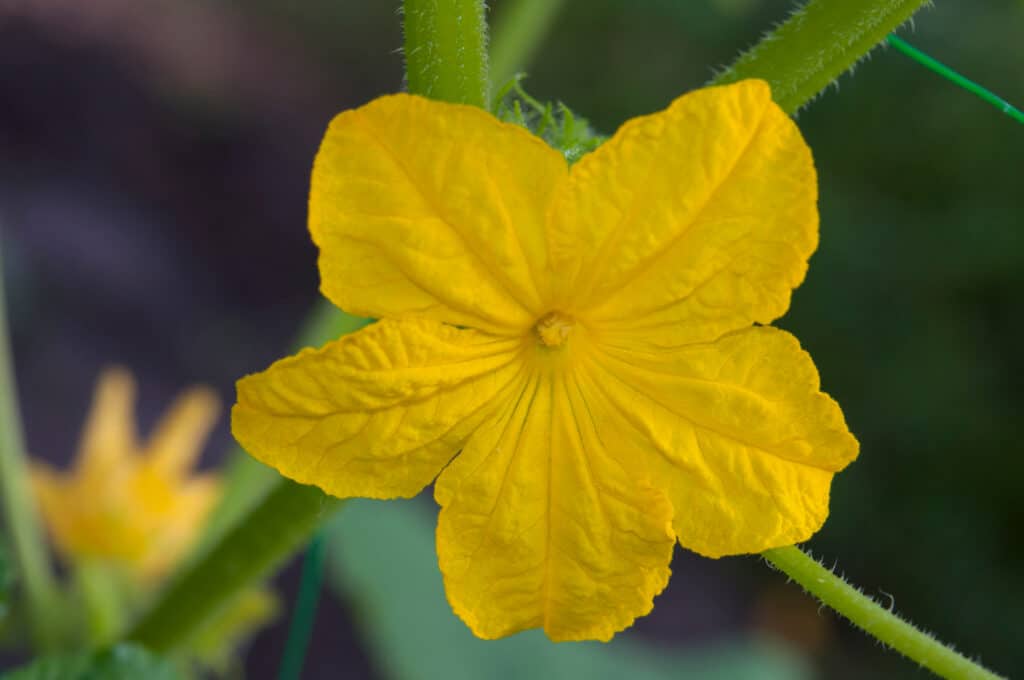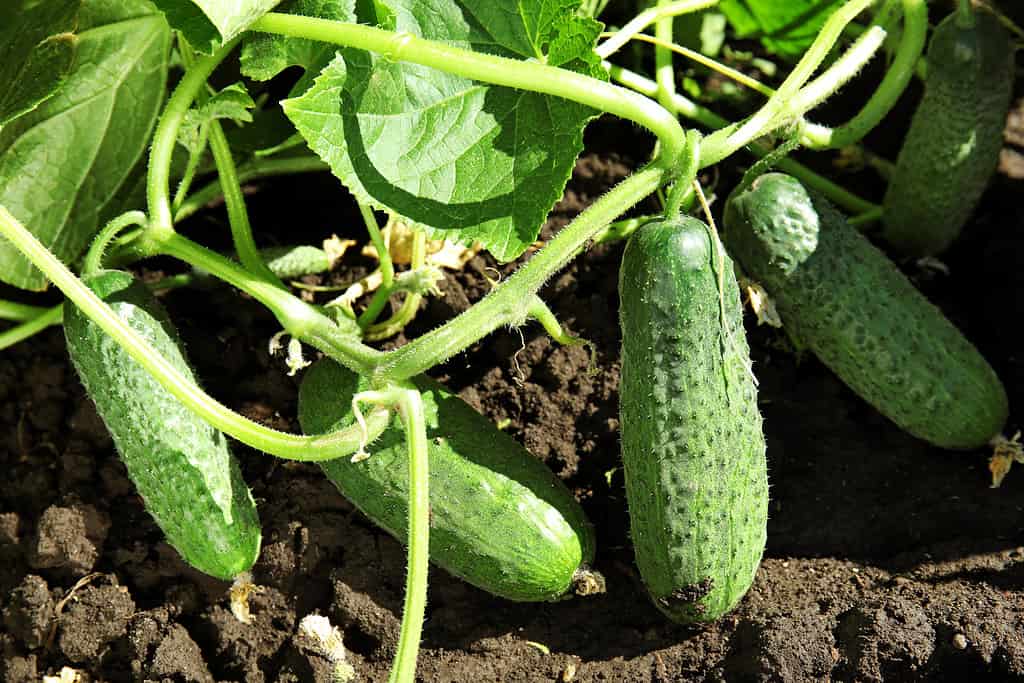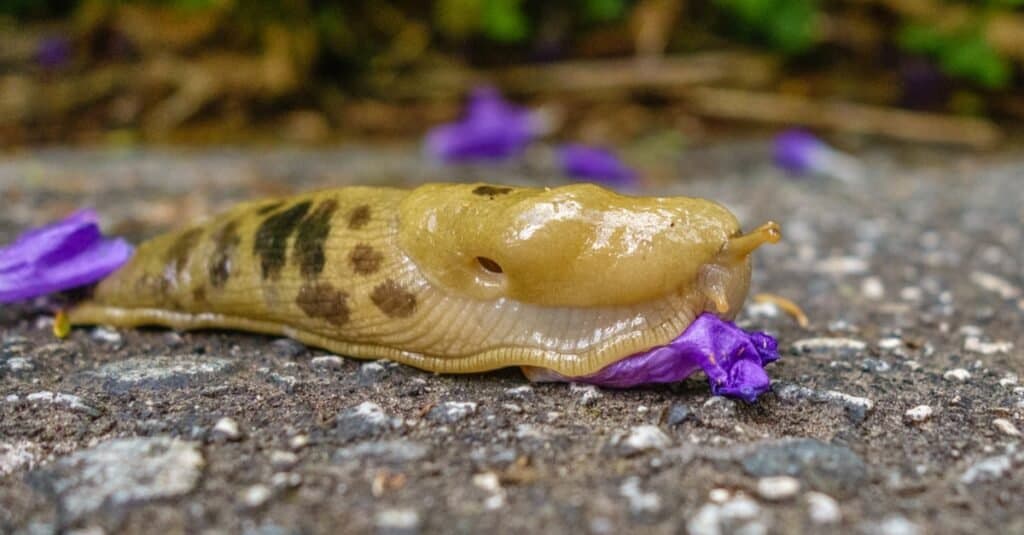Did you try your hand at backyard gardening and found your cucumbers hadn’t grown? You’re not alone. Even if you do everything right, there are still many reasons why your cucumbers didn’t grow this summer.
However, most issues with growing cucumber can be fixed with relatively simple solutions. If you kept notes of what happened to your cucumber plants, then identifying and correcting the issue will be easy. If your cucumber didn’t grow at all, or you don’t know what happened, then chances are the reason will be one the reasons we have listed below. That’s because we have collected the 3 most common reasons cucumber don’t grow. These include poor pollination, incorrect planting and soil conditions, and pests.
Reason #1: Poor Pollination

This is an open male cucumber flower. The center of the flower is where you can find the pollen used for pollination.
©olenaa/Shutterstock.com
If your cucumber plants grew, but didn’t even begin to fruit, it’s possible your plants didn’t germinate properly. Cucumber plants have both male and female flowers that bloom and must be germinated before a cucumber will begin to grow. Male flowers will bloom first, followed by the female version a couple weeks later. The female flower is capable of producing a cucumber, but must be pollinated first.
Next time you plant your cucumber seeds, keep an eye out for pollinating insects like bees visiting your flowers. If there are no insects visiting your plants, you may need to start hand-pollinating your flowers. There is no difference in fruit that were hand-pollinated from those that were pollinated naturally, but it will just require a little bit of extra work.
All you need is a cotton swab, or similar soft instrument, like a paintbrush, and some time. First, you will need to identify the male and female flowers. The male versions appear first and are shorter, while the female versions will have a miniature cucumber at their base. Gently dab the tip of the cotton swab on the center of a male flower, then rub it on the center of the female flower. It’s that easy.
If you did it correctly, then the miniature cucumber at the base of the female flower will grow into a mature cucumber.
Reason #2: Incorrect Planting and Soil Conditions

Healthy cucumber. Each variety will be different and should be harvested at different sizes. All will have uniform color when they are ready to be picked.
©New Africa/Shutterstock.com
If your plants didn’t grow at all, or quickly died after sprouting, your problem might be poor soil conditions or incorrect planting.
Like most fruits and vegetables, cucumbers require specific growing conditions to grow properly. Conditions that are too cold, too hot, too wet, or too dry will make it difficult for your plants to fruit successfully. Also, test your soil to make sure it’s not too acidic or basic.
If you are just trying to grow a single cucumber plant to test your green thumb, you might struggle to grow it indoors. Cucumbers require at least 6 to 8 hours of direct sunlight per day. If your plant is not getting that much indoors, you need to relocate your growing area.
When planting, we recommend you wait around a month after the last frost of the year. This is especially true if you don’t have a greenhouse or a special setup (with grow lights) for your plants. Cucumbers will grow best when the soil is around 70 degrees Fahrenheit. Though normal temperature fluctuations won’t affect your plants too much. Avoid temperatures below 60 degrees, however, as your plants won’t germinate at all below that temperature. Cheap thermometers available online are an easy way to make sure your soil is the right temperature before planting.
Make sure you are planting your seeds with 36 to 60 inches of space between them. Cucumbers grow on vines and take up a lot of space. So, if you were planting your seeds too close, they probably didn’t have enough room to grow and absorb nutrients and sunlight.
Additionally, cucumber seeds should be planted about 1 inch deep. Too shallow and they are easy targets for birds and other animals. Too deep and they will struggle to reach the surface for sunlight.
Reason #3: Pests

Slugs, like the Pacific Banana Slug, will devour your plants and destroy them very quickly. They have a special organ called a radula that has thousands of tiny protrusions that help them grind up their food, including your cucumbers!
©Heidi Besen/Shutterstock.com
There are many pests and diseases that can affect your vulnerable cucumber plant. Some of the most common include aphids, beetles, and fungus.
Aphids will cause a yellowing of your leaves and distort the shape of your vegetables. If left unchecked, they will ruin your crop entirely. The best way to treat them is to include companion plants in your garden. Additionally, you should remove them with water spray and wipe your plants clean regularly. Include plants that are native to your area so beneficial insects that feed on aphids are regular visitors of your garden.
Squash bugs love to eat cucumber seedlings, and will destroy your plants before they even have a chance to flower. Companion plants and natural plants which invite friendly insects will be your most powerful allies if squash bugs are your enemy.
Slugs have a particular appetite for young and ripe fruit. They can sneak into your garden and destroy a large portion of it before you even notice they are there. Use straw mulch to help keep them away, or use trellising to keep the cucumber vines off the ground and harder to reach.
Cucumber beetles, on the other hand, will eat your leaves and create large holes in your flowers, stems, and fruits. They also spread viruses and fungus that will destroy your plants.
Fungus that infects your roots and vegetables are a serious threat and hard to get rid of. You can prevent most fungus varieties, however, by taking simple steps. While it is too late to save your previous crop, knowing what signs to look out for next time will save you a lot of heartache.
Inspect your plants regularly. Look to see if the leaves have turned yellow or brown, or devevlop purple of black spots. See if there is any growth on the undersides of the leaf of any color (usually white or grey). Check for any distortion of the leaves or flowers, or any kind of powdery coating that appears on your plants suddenly. These are all signs of fungal infection.
Next time you want to plant cucumber, try to choose fungus-resistant varieties and plant them in full sun whenever you can. Definitely avoid overhead watering (like from a sprinkler or spray hose). Use a drip system or a soaker hose to make sure you are wetting the soil enough without over-watering. You don’t want to saturate the soil. Make sure the area where you grow your plants has good air circulation and use mulch to protect the soil around the root systems.
If your plants still get infected, remove them. Destroy the infected plant immediately without contaminating any of its neighbors.
Finally, there might be different diseases, pests, and challenges to growing your cucumber depending on where you live. Varying levels of humidity, local insects and animals, and other variables will be hard to treat if you’re not a seasoned grower in your area. Reach out to local farmers and learn what traditional practices they employ to ensure a successful harvest. Regional growers and back-yard farmers are always more than happy to give tips and family tricks.
The photo featured at the top of this post is © Ermolenko Aleksandra/Shutterstock.com
Thank you for reading! Have some feedback for us? Contact the AZ Animals editorial team.






